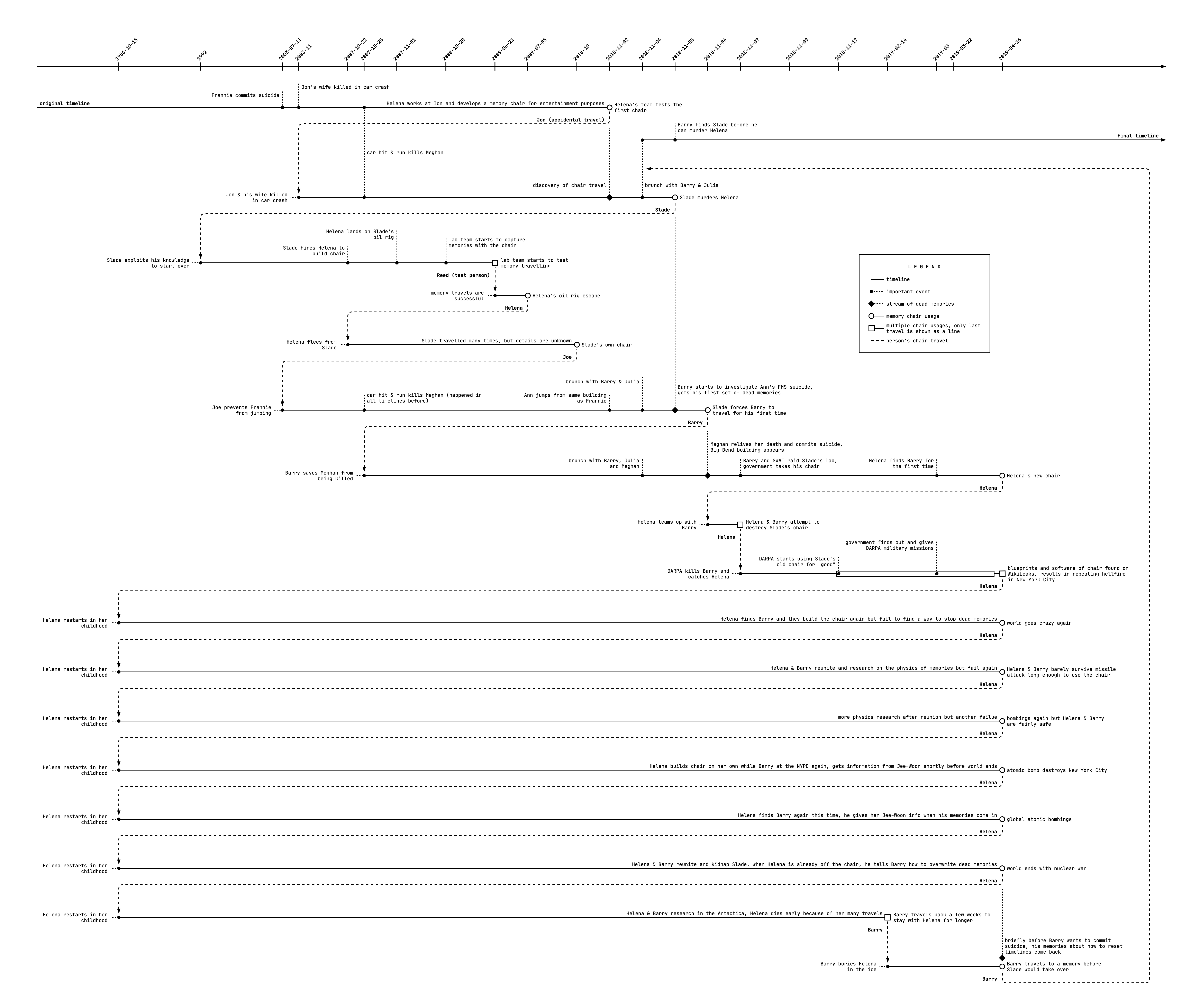The Timelines of Recursion
| 5 mins | Bobtags: book, visualisation, science-fiction
Good day everyone, nice to see you again. Today, I would like to share a great book with you and discuss its story a little.
With a few years delay after it came out in 2016, I have read Dark Matter by Blake Crouch1 this summer. I was a little sceptical whether I would like the story so much that I would overlook the somewhat far-fetched physical details. And certainly, I did, as I rated it 5/5. Just this week, I started reading his latest book Recursion2. Considering that my free time was very limited, it was a pretty fast read for me. And damn it was great.
! ! ! MASSIVE SPOILERS AHEAD ! ! !
I mean, when thinking about it now, the concept of “time travelling” through memories isn’t blowing me away too much—at least not as much as it did whilst reading. At least it’s not as much unrealistic as Dark Matter’s physics because it comes with a lot more philosophical aspects which I liked to think about. Crouch really went all-in with this plot, and I couldn’t imagine more dramatic events compared to what he served up. Anyways, this post is not meant to be a review of the book (there are already plenty).
Instead, I am going to give my best to visualize the story and explain all major timelines in as much detail as makes sense. The book neither follows a time-based order, nor does it always stick with the direction of causation as Crouch shuffles the time snippets in a way that provides the most thrilling buildup. My goal is now to put everything in the correct order.3
Again, if you haven’t read the book yet but you plan to do so, you probably do not want to continue!
Mechanics
First, some notes to support further understanding of the mechanics of the chair and the timelines Crouch described:
- You first have to map the person’s synapses while they strongly concentrate on a certain memory. For this, a MEG-microscope and the actual chair is used.
- To send the person back in time to the saved memory, they climb into a deprivation tank where their heart is stopped and when their brain releases DMT (Dimethyltryptamine), the captured memory is played.
- The person starts to relive the memory passively and when it ends they can interact with the surroundings again. They still know everything that happened before using the chair but it is slowly overtaken by memories of the new timeline. The old timelines become dead memories that feel lifeless.
- When the moment has come in which the person used the chair in the last timeline, other people whose life is now altered due to different actions of the traveller experience severe headaches and nosebleeds. After that, they remember everything from the previous timelines up to the point where a chair usage happened chronologically after the more recent one. Timelines before that point are overwritten and disappear. The transition of memories for these passively influenced people feels similar to that of the traveller when using the chair, i.e. they feel like jumping from the old timeline into the new one and then slowly remember the new timeline’s past.4
Timelines
Below is a small preview of what I’ve put together. Click on it to open the diagram in a new tab where you can zoom in and pan around; zoom controls are on the top left of the screen. If you read this on a phone, you should long-hold the image and open the picture instead as navigation is easier here. Check the legend box on the right first to understand what each line or symbol means.
I hope I haven’t forgotten anything important, but if I have, feel free to write me a comment below and I will try to update the graphics. By creating it I have dealt with the book quite extensively and often skimmed back and forth. So if you have also read the book and don’t understand something, I might as well be able to help you.
See you soon!
-
Other people may already have done something similar but I did not copy anyone’s work. I made this post and the timeline graphics mainly because I wanted to understand the fantastic book I’ve just read a little better and somewhat conclude my thoughts. ↩
-
This is indicated several times: Meghan felt like she just died in the car hit and run and suddenly finds herself in her apartment. People in New York City watch the Big Bend “materialize” in front of them because it didn’t exist in the previous timeline where its architect was murdered. Later, when Helena travels back to her childhood, Barry experiences that things (shockwaves, rain, flames etc.) move slower and slower until time stops, then he jumps to the new timeline. ↩

